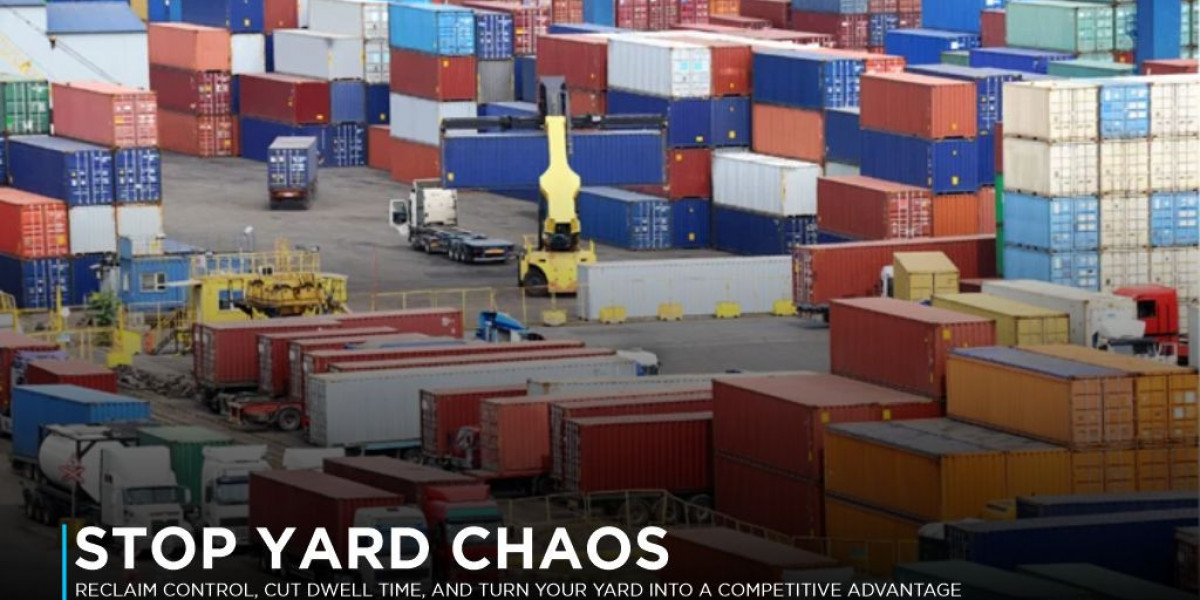Yards are where promises meet pavement — and where logistics plans either succeed or evaporate. When trailers sit confused at the gate, drivers wait for hours, and dock doors become battlegrounds, the ripple effects hit service levels, labor costs, and customer trust. A modern Yard Management Solution (YMS) does more than track trailers — it orchestrates arrival, staging, dwell, and departure so your yard stops being a liability and becomes a predictable, measurable asset.
This guide is written for B2B leaders: logistics heads, operations managers, IT architects, and supply chain executives who need a practical, vendor-agnostic roadmap to evaluate, deploy, and capture value from YMS.
What a Yard Management Solution actually does (in plain business terms)
A YMS is the operational layer that manages the choreography of vehicles, trailers, containers, and docks around your facility. It gives you:
Gate control — fast capture of arrival info, driver instructions, and checklists.
Staging & parking optimization — where each trailer should wait so it’s ready for the right dock or next movement.
Dock scheduling & appointment enforcement — synchronize arrivals with available capacity to reduce congestion.
Dwell and detention tracking — measure how long assets stay on site and trigger actions to reduce dwell.
Real-time visibility & alerts — location and status for every trailer, plus automated notifications for exceptions.
Work orchestration — assign trailer moves, yard checks, and loading/unloading tasks to crews or automated equipment.
In short: YMS reduces guesswork, prevents wasted movements, and shortens lead times between arrival and departure.
Why this matters for B2B operations (the business case, emotionally framed)
Picture this: a sales team promises next-day delivery; a planner books a carrier; a driver shows up — but the yard is a mess. Trailers are double-parked, the right load isn’t at the dock, and expensive overtime is the only option. That mismatch destroys margins and credibility.
YMS changes that story. It makes yard throughput predictable, slashes detention charges, cuts wasted moves, and frees operations teams from firefighting. For businesses that live and die by reliable deliveries — manufacturers, retailers, distributors, and 3PLs — a disciplined yard is a direct line to customer satisfaction and lower cost-to-serve.
Core capabilities to demand from any YMS
When evaluating solutions, make sure they cover these essentials:
Real-time trailer and asset tracking — not just a log of arrivals, but location-level status (gate, check-in, stall, dock, released).
Appointment booking & dock scheduling — two-way scheduling with carriers and integration with planning systems to smooth dock utilization.
Automated gate workflows — fast, mobile-driven check-in/check-out, and document capture (e.g., BOL, seals, scans).
Yard optimization & staging rules — rules-based placement to keep frequently used trailers close to docks or to stage by priority.
Task orchestration — assign moves to drivers, yard jockeys, or automated vehicles, with mobile confirmations.
Exception management & alerts — configurable triggers for overstay, missed appointments, wrong shipments, or safety issues.
Integration readiness — seamless interfaces with WMS, TMS, ERP, and telematics/GPS providers.
Analytics & SLAs — dashboards for dwell time, detention costs, moves per yard crew, and gate throughput.
If a product lacks strong integration points with your WMS/TMS/ERP, it will create more friction than value.
Integration: where YMS creates multiplier effects
YMS is most powerful when integrated into your broader supply chain systems:
WMS — synchronizes inbound/outbound loads so dock doors and yard spots match what warehouse ops expect.
TMS — aligns arrivals and departures with plan, feeds appointment data, and reduces empty run times.
ERP — ties yard events to financials (detention charges, carrier claims) and inventory ownership timing.
Telematics / GPS — brings carrier location into gate ETAs for dynamic appointment adjustments.
Integration turns isolated visibility into coordinated action: fewer surprises, fewer manual phone calls, and a single source of truth for asset location and status.
Measurable business benefits (what you can realistically expect)
When implemented well, YMS delivers clear, measurable outcomes:
Reduced dwell time — often 20–50% improvement within months for facilities with chronic yard congestion.
Lower detention & demurrage costs — fewer chargeable hours when trailers move quicker.
Fewer yard moves — optimized staging cut internal repositioning, saving labor and equipment wear.
Faster gate throughput — reduced queues and shorter driver wait times improve carrier satisfaction.
Improved dock utilization — higher percentage of time doors are used for productive loading/unloading.
Better invoice reconciliation — automated timestamps and proofs speed disputes and settle claims faster.
Quantify these with a simple baseline: average dwell per trailer, moves per 100 trailers, dock utilization, and detention cost per month.
A practical phased implementation roadmap
Phase 0 — Assess & baseline (2–4 weeks)
Map current yard layouts, average arrival patterns, peak times, and pain points.
Capture key metrics: average dwell, moves per trailer, gate throughput, and detention spend.
Phase 1 — Pilot (6–10 weeks)
Pick 1–2 gates and a subset of carriers. Implement gate automation, appointment booking, and basic staging rules.
Validate mobile check-in, trailer placement, and core KPIs.
Phase 2 — Expand (8–16 weeks)
Broaden to all gates, integrate with WMS/TMS, and onboard more carriers. Add task orchestration and telematics feeds.
Introduce dashboards and daily operating routines.
Phase 3 — Optimize (ongoing)
Tune staging algorithms, implement yard crew performance plans, and automate exception workflows.
Use analytics to shift appointments away from peak congestion or to reassign dock capacity.
Keep iterations small, focus on measurable wins, and maintain strong collaboration with carriers and dock teams.
KPIs you must track from day one
Average dwell time per trailer (hours)
Gate processing time (minutes per truck)
Moves per trailer (average)
Dock utilization %
Detention/demurrage costs per month
On-time appointment arrival %
Yard crew productivity (moves per hour)
Establish baselines before go-live and show progress in weekly executive scorecards during the first three months.
Common pitfalls and how to avoid them
Treating YMS as a point solution — without WMS/TMS integration, YMS becomes another silo. Plan integrations early.
Ignoring carrier change management — carriers are critical partners; get them on board with appointment rules and gate processes.
Over-automation without process clarity — automate after you standardize processes; automating broken workflows speeds failure.
Poor master data — inaccurate trailer IDs, shipment references, or location codes break visibility and reconciliation. Clean data first.
Undertraining frontline staff — gate agents, yard jockeys, and dock supervisors must be trained and coached on the new workflows.
Address these proactively and the solution becomes an enabler, not a new headache.
Who needs to be on the project team
Logistics/Operations leader — project sponsor and operational owner.
Yard operations manager — process lead and daily owner.
Integration architect — handles WMS/TMS/ERP/telematics interfaces.
IT security & network — ensures gate equipment and mobile devices are secure and reliable.
Carrier liaison — coordinates onboarding and communication with trucking partners.
Change manager & trainers — manage adoption among gate, yard, and dock staff.
Data steward — maintains trailer, vehicle, and location master data.
Cross-functional ownership ensures operational realities guide technical choices.
ROI modeling — keep it simple
Estimate ROI by modeling three levers:
Labor savings — fewer moves and less yard jockey time.
Detention savings — reduced hours charged by carriers.
Throughput gains — better dock utilization reduces missed shipments and expedited freight spend.
Build a 12–24 month model: one-time implementation cost (software + devices + integration) vs. monthly savings. In many cases, payback occurs within 9–18 months for mid-sized distribution centers with chronic yard issues.
Quick decision checklist for executives
Do we have measurable yard pain (dwell, detention, wasted moves)?
Can we commit to integrating YMS with WMS/TMS/telematics?
Will our carriers participate in appointment booking and gate workflows?
Do we have a pilot gate and a data-cleanup plan ready?
Is there an operations leader willing to own day-to-day change?
If the answer is “yes” to most, you’re ready to pilot.
Closing — make the yard predictable, not painful
Yard Management Solutions are not cool shiny tools — they are practical enablers that turn chaos into throughput. For B2B operations where reliability and cost control matter, a well-executed YMS project reduces friction, clears gates, and lets your team focus on higher-value logistics problems. Start small, measure everything, integrate broadly, and treat carriers as partners — the yard will stop being the bottleneck and become a source of competitive advantage.








